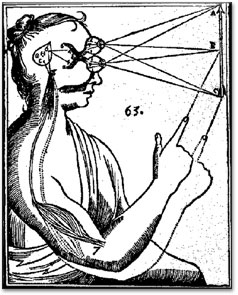It becomes harder yet to believe in a coincidence when we discover that the metaphor also occurs in Leonardo's notebooks. In discussing the question of whether rays of light emanate from the eye or from the bodies that are seen, Leonardo expresses the view that "the eye [is] adapted to receive like the ear the images of objects without transmitting some potency in exchange for these" (Leonardo da Vinci, 1938, p. 251). And then, to support his view, he says:
The circle of the light [color]
which is in the middle of the white of the eye is by nature suitable
to apprehend objects. This same circle has in it a point which seems black
and this is a nerve bored through it which goes within the seat of the powers
charged with the power of receiving impressions and forming judgment, and
this penetrates to the common sense. Now the objects which are over against
[across from] the eyes act with the rays of
their images after the manner of many archers who wish to shoot through
the bore of a carbine, for the one among them who finds himself looking
down the barrel of a15 carbine will be most likely to touch the
bottom of this bore with his arrow; so the objects opposite to the
eye will be more transferred to the sense when they are in line with the
transfixing nerve. (Emphasis ours. Translation amended by the authors. Leonardo
da Vinci, 1938, p. 252)
 |
|
|
 |
|
|
| Fig
1.17 Arrow as generalized object, from Descartes's Le Monde.
Woodblock cut from designs found in Descartes's manuscript, or from
drawings by Gérard de Gutschoven and Louis de La Forge
|
|
|
Every technical field develops certain stock images
that are proven pedagogical tools. For example, Descartes, in his posthumously
published Le monde, ou traité de la lumière (1664),
used arrow to represent a generalized object (Figure 1.17). It would be a
very unlikely coincidence if three Renaissance authors used the arrow-in-the-eye
metaphor in discussing perspective and optics unless it had become part of
the imagery involved in thinking about perspective, a metaphor they lived
by.16
But if a small circle of experts lived by this metaphor, could Mantegna expect his audience to read this undeclared rebus? We believe so. Puzzles and esoteric allusions were a pervasive feature of Florentine art. Renaissance Florentines, for all their interest in geometry and mathematics, should by no means be considered to be rationalists in the post-Cartesian sense. Indeed, shortly after Mantegna painted the frescoes in the Ovetari Chapel, in 1460, Marsilio Ficino (1433-99), a priest, the founder of the Platonic Academy in Florence, and one of the quattrocento's most influential philosophers, translated part of the Hermetic literature, a collection of treatises concerned with astrology, alchemy, and other occult sciences, written between CE 100 and 300. The text appears to have filled a need and gained a wide readership. As Welliver says:
One very strong manifestation of the tendency of Florentine art to be intellectual was the Florentine penchant for the subtle and the esoteric. The Florentine artist or poet frequently spoke a much different message to the initiate from that received by the profane; indeed it would hardly be an exaggeration to say that the most typical kind of Florentine work was a riddle concealed from the profane by the trappings of innocence. This was a tradition sanctified by the example of Dante and increasingly reinforced, throughout the fifteenth century, by the rediscovery of Plato. It was the consistent element in Florentine nature which impelled the observant Jew from abroad, Joachim Alemanni, to write in 1490 that no people had ever been so given to communication by parable and riddle as the Florentines. (Welliver, 1973, p. 20)
It should be noted that these observations can legitimately be generalized to include the artists of Padua as well, because many artists of Florentine origin were active in the North (Gentile da Fabriano and Pisanello in Venice; Andrea del Castagno in San Zaccaria; Filippo Lippi, Paolo Uccello, and especially Donatello in Padua).
Thus, by showing that the arrow in the eye may have been a commonly used metaphor in Renaissance artistic circles, and that esoteric references were common in Renaissance art, we support our claim that Mantegna's audience would appreciate an oblique reference to perspective in a painting.
The thesis of this book is that there is yet another
role for perspective in Renaissance art. It is a subtle role, having to do
with the spectator's experience of his or her location in space with respect
to the physical surface of the painting and with respect to the room in which
the painting is viewed. We will show in the following chapters that Renaissance
painters deliberately induced a discrepancy between the spectator's actual
point of view and the point of view from which the scene is felt
to be viewed. The result is a transcendent experience that cannot be obtained
by any other means. So, whether or not Mantegna intended the arrow in the
eye to draw the spectator's attention to the deeper significance of perspective,
we hope this book will achieve that goal.
